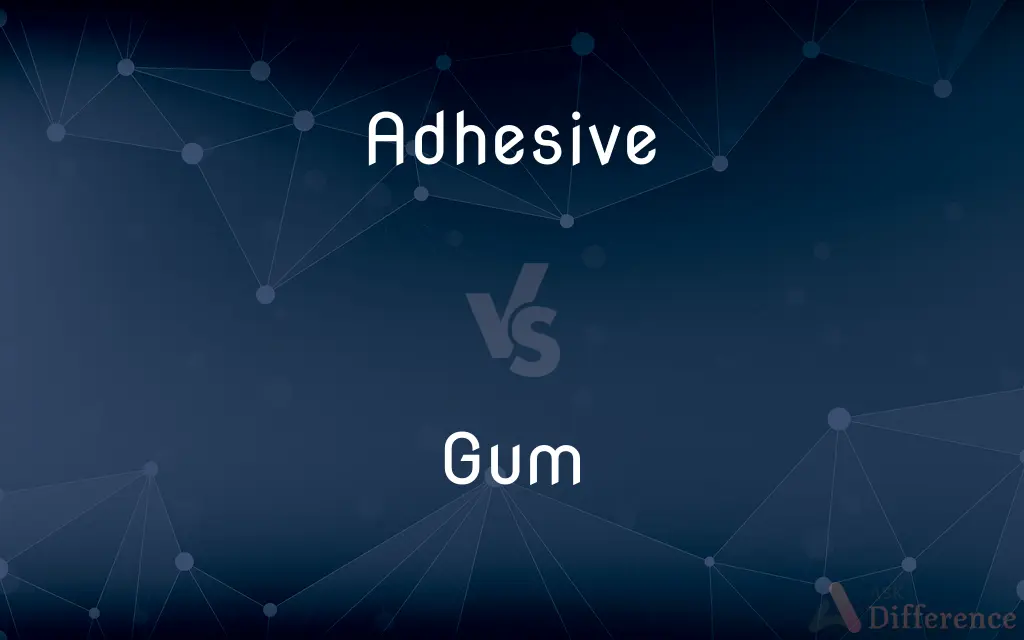Adhesive vs. Gum — What's the Difference?
By Urooj Arif & Maham Liaqat — Updated on May 9, 2024
Adhesive is a binding agent used to adhere objects together, designed for durability and strength, while gum primarily refers to substances that are chewable and malleable, often used for recreational chewing or as a less strong, natural adhesive.

Difference Between Adhesive and Gum
Table of Contents
ADVERTISEMENT
Key Differences
Adhesive is formulated to create a strong, permanent, or semi-permanent bond between different materials, such as metal, wood, or plastic. It includes varieties like epoxies, glues, and cements that are crucial in construction and manufacturing. Gum, on the other hand, usually refers to natural or synthetic substances that are chewable and used primarily for enjoyment, like chewing gum, or derived from natural sources like gum arabic, which serves as a mild adhesive in culinary and artistic applications.
Adhesives are chosen based on the required strength, flexibility, and environmental resistance of the bond they need to form. Industrial adhesives can withstand extreme conditions, such as high temperatures and moisture. Gum, whereas, is selected based on its texture and flavor when used for chewing, and its binding ability in less demanding adhesive roles, like sealing envelopes or applying labels.
The application process for adhesives varies from simple household glue sticks to complex industrial adhesive applications requiring precise mixing and curing conditions. Gum, on the other hand, is generally used directly in its natural state or after minimal preparation, like softening or melting.
Adhesives often contain chemicals that can be hazardous, requiring careful handling, proper ventilation, and sometimes protective equipment. Gum is typically non-toxic and safe for consumption or regular handling, making it more user-friendly in everyday situations.
While adhesives are an essential component in various industries, including automotive, aerospace, and electronics, providing structural integrity, gum is widely used in food and art, emphasizing its versatile but less structural nature.
ADVERTISEMENT
Comparison Chart
Primary Use
Bonding materials together
Chewing or mild adhesive tasks
Composition
Synthetic polymers, resins, or natural bases
Natural tree saps, synthetic rubbers
Application
Requires preparation and curing
Used directly or after minimal preparation
Safety
Often toxic, requires precautions
Generally non-toxic, safe for consumption
Industry Relevance
Crucial in construction, automotive
Used in food, arts, and crafts
Compare with Definitions
Adhesive
A material capable of holding materials together by surface attachment.
The plumber used a strong adhesive to seal the leak.
Gum
Any viscous or sticky substance resembling tree gum.
Be careful with that gum on the pavement.
Adhesive
Substance used to bind surfaces together.
Adhesive tape is used to repair torn paper.
Gum
Grind with the gums; chew without teeth and with great difficulty;
The old man had no teeth left and mumbled his food
Adhesive
Used metaphorically to describe something that binds figuratively.
Shared interests are the adhesive that bonds our group.
Gum
Exude or form gum;
These trees gum in the Spring
Adhesive
A glue or cement type.
This project requires a waterproof adhesive.
Gum
A substance exuded by certain plants that is sticky when moist.
Gum arabic is used in making paints.
Adhesive
Any agent that promotes adhesion.
An adhesive layer is necessary for these tiles.
Gum
Used to describe the flesh around the teeth.
Good oral hygiene keeps your gums healthy.
Adhesive
Adhesive, also known as glue, cement, mucilage, or paste, is any non-metallic substance applied to one or both surfaces of two separate items that binds them together and resists their separation.The use of adhesives offers certain advantages over other binding techniques such as sewing, mechanical fastenings, or welding. These include the ability to bind different materials together, the more efficient distribution of stress across a joint, the cost-effectiveness of an easily mechanized process, and greater flexibility in design.
Gum
Any of various viscous substances that are exuded by certain plants and trees and dry into water-soluble, noncrystalline, brittle solids.
Adhesive
Tending to adhere; sticky.
Gum
A similar plant exudate, such as a resin.
Adhesive
Gummed so as to adhere.
Gum
Any of various adhesives made from such exudates or other sticky substance.
Adhesive
Tending to persist; difficult if not impossible to shake off
"He feels an adhesive dread, a sudden acquaintance with the ... darker side of mankind" (George F. Will).
Gum
A substance resembling the viscous substance exuded by certain plants, as in stickiness.
Adhesive
A substance, such as paste or cement, that provides or promotes adhesion.
Gum
Any of various trees, especially of the genera Eucalyptus and Liquidambar, that are sources of gum. Also called gum tree.
Adhesive
Sticky; tenacious, as glutinous substances
Adhesive material
Adhesive tape
Gum
The wood of such a tree; gumwood.
Adhesive
Apt or tending to adhere; clinging
Gum
Chewing gum.
Adhesive
A substance, such as glue, that provides or promotes adhesion
Gum
The firm connective tissue covered by mucous membrane that envelops the alveolar arches of the jaw and surrounds the bases of the teeth. Also called gingiva.
Adhesive
Sticky; tenacious, as glutinous substances.
Gum
To cover, smear, seal, fill, or fix in place with gum.
Adhesive
Apt or tending to adhere; clinging.
Gum
To exude or form gum.
Adhesive
A substance that unites or bonds surfaces together
Gum
To become sticky or clogged.
Adhesive
Tending to adhere
Gum
To chew (food) with toothless gums.
Gum
The flesh around the teeth.
Gum
Any of various viscous or sticky substances that are exuded by certain plants.
Gum
Any viscous or sticky substance resembling those that are exuded by certain plants.
Gum
Chewing gum.
Gum
(countable) A single piece of chewing gum.
Do you have a gum to spare?
Gum
A gummi candy.
Gum
A hive made of a section of a hollow gum tree; hence, any roughly made hive.
Gum
A vessel or bin made from a hollow log.
Gum
A rubber overshoe.
Gum
A gum tree.
Gum
To chew, especially of a toothless person or animal.
Gum
(transitive) To deepen and enlarge the spaces between the teeth of (a worn saw), as with a gummer.
Gum
To apply an adhesive or gum to; to make sticky by applying a sticky substance to.
Gum
To stiffen with glue or gum.
Gum
To inelegantly attach into a sequence.
Gum
To impair the functioning of a thing or process.
That cheap oil will gum up the engine valves.
The new editor can gum up your article with too many commas.
Gum
The dense tissues which invest the teeth, and cover the adjacent parts of the jaws.
Gum
A vegetable secretion of many trees or plants that hardens when it exudes, but is soluble in water; as, gum arabic; gum tragacanth; the gum of the cherry tree. Also, with less propriety, exudations that are not soluble in water; as, gum copal and gum sandarac, which are really resins.
Gum
See Gum tree, below.
Gum
A hive made of a section of a hollow gum tree; hence, any roughly made hive; also, a vessel or bin made of a hollow log.
Gum
A rubber overshoe.
Gum
To deepen and enlarge the spaces between the teeth of (a worn saw). See Gummer.
Gum
To smear with gum; to close with gum; to unite or stiffen by gum or a gumlike substance; to make sticky with a gumlike substance.
He frets like a gummed velvet.
Gum
To chew with the gums, rather than with the teeth.
Gum
To exude or form gum; to become gummy.
Gum
A preparation (usually made of sweetened chicle) for chewing
Gum
The tissue (covered by mucous membrane) of the jaws that surrounds the bases of the teeth
Gum
Any of various substances (soluble in water) that exude from certain plants; they are gelatinous when moist but harden on drying
Gum
Cement consisting of a sticky substance that is used as an adhesive
Gum
Wood or lumber from any of various gum trees especially the sweet gum
Gum
Any of various trees of the genera Eucalyptus or Liquidambar or Nyssa that are sources of gum
Common Curiosities
Is adhesive safe to consume?
Most adhesives are not safe for consumption due to their chemical components.
What is chewing gum made from?
Chewing gum is typically made from synthetic rubbers or natural substances like chicle.
Can gum be used as an adhesive?
Yes, certain types of gum, like gum arabic, can be used as a mild adhesive for light bonding tasks.
How are adhesives tested for strength?
Adhesives are tested using tensile, shear, and peel tests to determine their bonding capabilities.
What precautions should I take when using strong adhesives?
Use protective gear, ensure good ventilation, and follow the manufacturer's instructions carefully.
Are all gums adhesive?
Not all gums are adhesive; many are designed for chewing and have no adhesive properties.
How long does chewing gum flavor last?
The duration of the flavor depends on the gum's ingredients and the individual's chewing action.
What are the main uses of adhesive?
Adhesive is primarily used for binding materials together in various industries, providing durability and resistance.
Can I use gum to fix a leak?
Gum is not suitable for fixing leaks due to its low adhesive strength and durability.
How do I choose the right adhesive for a project?
Choosing the right adhesive depends on the materials involved, the required strength of the bond, and environmental exposure.
Can gum be harmful if swallowed?
Chewing gum is generally harmless if swallowed, as it passes through the digestive system without being digested.
What are natural sources of gum?
Natural gums are sourced from various plants and trees, such as gum arabic from the acacia tree.
Is there an eco-friendly adhesive?
Yes, there are eco-friendly adhesives made from biodegradable or recyclable materials.
What is the difference between natural and synthetic gum?
Natural gum is derived from plant sources and is biodegradable, whereas synthetic gum is made from man-made materials and can offer different textures and flavors.
Can adhesive be used on all materials?
Certain adhesives are formulated specifically for specific materials, and not all adhesives work with all materials.
Share Your Discovery

Previous Comparison
Scissor vs. Scissors
Next Comparison
Purse vs. ClutchAuthor Spotlight
Written by
Urooj ArifUrooj is a skilled content writer at Ask Difference, known for her exceptional ability to simplify complex topics into engaging and informative content. With a passion for research and a flair for clear, concise writing, she consistently delivers articles that resonate with our diverse audience.
Co-written by
Maham Liaqat















































